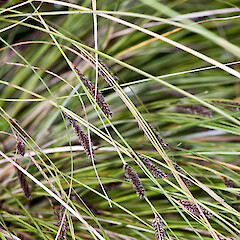Carex flagellifera
Common name
Glen Murray tussock, trip me up
Synonyms
Carex lucida Boott
Family
Cyperaceae
Flora category
Vascular – Native
Endemic taxon
Yes
Endemic genus
No
Endemic family
No
Structural class
Sedges
NVS code
The National Vegetation Survey (NVS) Databank is a physical archive and electronic databank containing records of over 94,000 vegetation survey plots - including data from over 19,000 permanent plots. NVS maintains a standard set of species code abbreviations that correspond to standard scientific plant names from the Ngä Tipu o Aotearoa - New Zealand Plants database.
CARFGL
Chromosome number
2n = c.58
Current conservation status
The conservation status of all known New Zealand vascular plant taxa at the rank of species and below were reassessed in 2017 using the New Zealand Threat Classification System (NZTCS) – more information about this can be found on the NZTCS website. This report includes a statistical summary and brief notes on changes since 2012 and replaces all previous NZTCS lists for vascular plants.
Please note, threat classifications are often suggested by authors when publications fall between NZTCS assessment periods – an interim threat classification status has not been assessed by the NZTCS panel.
- Conservation status of New Zealand indigenous vascular plants, 2017 . 2018. Peter J. de Lange, Jeremy R. Rolfe, John W. Barkla, Shannel P. Courtney, Paul D. Champion, Leon R. Perrie, Sarah M. Beadel, Kerry A. Ford, Ilse Breitwieser, Ines Schönberger, Rowan Hindmarsh-Walls, Peter B. Heenan and Kate Ladley. Department of Conservation. Source: NZTCS and licensed by DOC for reuse under the Creative Commons Attribution 4.0 International licence.
2017 | Not Threatened
Previous conservation statuses
2012 | Not Threatened
2009 | Not Threatened
2004 | Not Threatened
Distribution
Endemic. New Zealand: North, South, Stewart and Chatham Islands.
Habitat
Coastal to montane. Usually in free draining soils under scrub or open forest. Rarely in wetlands or in permanently damp, shaded sites.
Wetland plant indicator status rating
Information derived from the revised national wetland plant list prepared to assist councils in delineating and monitoring wetlands (Clarkson et al., 2021 Manaaki Whenua – Landcare Research Contract Report LC3975 for Hawke’s Bay Regional Council). The national plant list categorises plants by the extent to which they are found in wetlands and not ‘drylands’. The indicator status ratings are OBL (obligate wetland), FACW (facultative wetland), FAC (facultative), FACU (facultative upland), and UPL (obligate upland). If you have suggestions for the Wetland Indicator Status Rating, please contact: [Enable JavaScript to view protected content]
FACU: Facultative Upland
Occasionally is a hydrophyte but usually occurs in uplands (non-wetlands).
Detailed description
Usually densely tufted, dark green, yellow-green to red-green plants. Culms 350–750–(900) × 0.5–1.0 mm, or slightly wider, close-packed, trigonous or subtrigonous, smooth or slightly scabrid for a short distance below inflorescence, usually elongating in fruit up to c. 2.8 m, initially erect, soon prostrate and long trailing; basal sheaths dark brown, occasionally tinged with red-purple, nerves ± distinct. Leaves numerous, usually > culms, 1.5–2.5–(4.0) mm. wide, bright shining green, yellow-green or reddish, spreading or drooping at the tips, channelled, margins sharply scabrid. Spikes 4–8; terminal 1–2–(3) spikes male, close together, slender; remaining spikes female, 15–30–(40) × 3–5 mm, usually distant, usually pedunculate but ± erect, often male at the base, rarely male at the top also. Glumes ± = utricles, broadly ovate, usually obtuse, often with fimbriate margins, occasionally almost emarginate, subcoriaceous, dark or light red-brown, occasionally distinctly nerved, midrib distinct and thickened, conspicuously light brown, almost cream, produced to a short, slightly scabrid awn. Utricles 2.0–2.5–(3.0) × c. 1.5 mm, unequally biconvex, almost plano-convex, elliptic-ovoid, light brown at base, usually dark brown towards the top, smooth and shining, or faintly nerved on the more convex face, margins glabrous, rarely very slightly scabrid below beak; beak c. 0.4 mm long, acutely bidentate, margins slightly scabrid; stipe c. 0.3 mm. long. Stigmas 2. Nut < 1.5 mm long, biconvex, ovoid-oblong, dark brown.
Similar taxa
Carex flagellifera belongs to a complex of allied species which include the South Island, ultramafic endemic C. devia Cheesemanii, C. raoulii Boott, C. testacea Solander ex Boott and C. goyenii Petrie. From all these species C. flagellifera is best distinguished by its usually long trailing fruiting culms, narrow, channelled leaves, and usually distant, pendent female spikes. It is perhaps closest to C. testacea (itself a species complex). From that species, at least in its typical form it differs by the usually yellow-green to dark green, rather than orange-red to red-green culms, and red brown to dark red-brown, subcoriaceous rather than membranous, light brown glumes, which lack the numerous fine, red-brown striae typical of the most widespread form of C. testacea.
Flowering
September–November
Fruiting
Throughout the year
Life cycle
Nuts surrounded by inflated utricles are dispersed by granivory and wind (Thorsen et al., 2009).
Propagation technique
Easily grown from fresh seed and by the division of established plants. An attractive sedge whose usually long trailing fruiting culms look spectacular if plants are grown along the top of a wall. Carex flagellifera is a variable species and would repay some horticultural selection.
Etymology
carex: Latin name for a species of sedge, now applied to the whole group.
flagellifera: From the Latin flagrum ‘whip’ and ferre ‘to bear’, meaning bearing a whip-like appendage
Attribution
Fact Sheet prepared by P.J. de Lange (10 August 2006). Description adapted from Moore and Edgar (1970)
References and further reading
Moore LB, Edgar E. 1970. Flora of New Zealand, Volume II. Indigenous Tracheophyta: Monocotyledones except Gramineae. Government Printer, Wellington, NZ. 354 p.
Thorsen MJ, Dickinson KJM, Seddon PJ. 2009. Seed dispersal systems in the New Zealand flora. Perspectives in Plant Ecology, Evolution and Systematics 11: 285–309.
NZPCN Fact Sheet citation
Please cite as: de Lange, P.J. (Year at time of access): Carex flagellifera Fact Sheet (content continuously updated). New Zealand Plant Conservation Network. https://www.nzpcn.org.nz/flora/species/carex-flagellifera/ (Date website was queried)


















